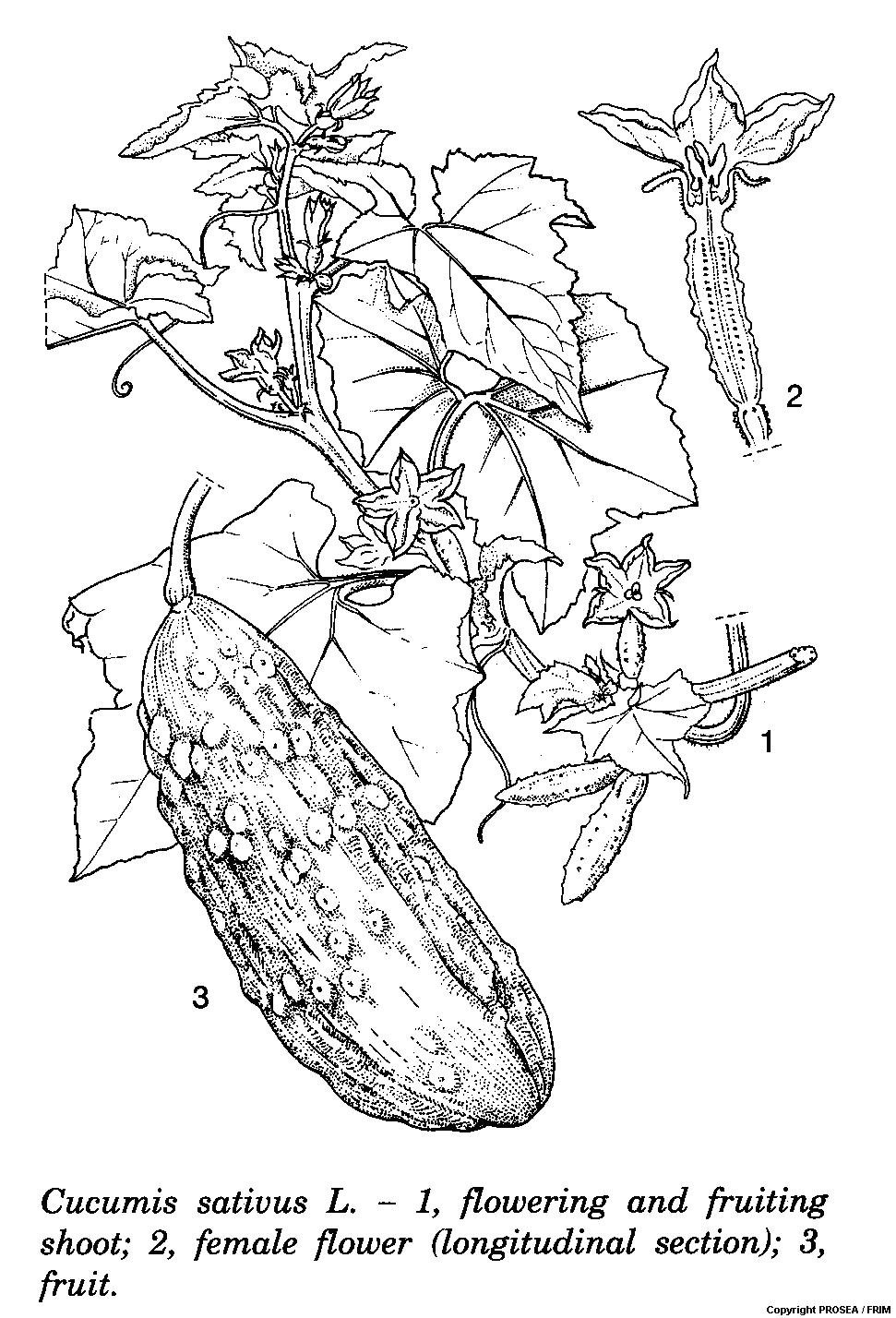Cucumis sativus L.
Family
Cucurbitaceae
Synonyms
None
Vernacular Names
|
Malaysia |
Timun, mentimun. |
|
English |
Cucumber, gherkin. |
|
Indonesia |
Ketimun, mentimun (Javanese), bonteng (Sundanese). |
|
Papua New Guinea |
Kukamba, kuikamba. |
|
Philippines |
Pipino (Tagalog), kalabaga (Bisaya), kasimum (Bontoc). |
|
Burma |
Thakhwa. |
|
Cambodia |
Trâsâk. |
|
Laos |
Tèèng. |
|
Thailand |
Taeng-kwa (General), taeng-ran, taengom (Northern). |
|
Vietnam |
D[uw]achu[ooj]t, d[uw]a leo. |
|
French |
Concombre, cornichon. |
Geographical Distributions
Cucumis sativus is not known from the wild. Although most Cucumis species have an African origin, C. sativus is believed to originate from the foothills of the Himalayas, where the closely related wild species C. hardwickii Royle still occurs. In India, the cucumber was already being cultivated 3000 years ago, and it was known in ancient Egypt, Greece and the Roman Empire. In the 6th Century, it was cultivated in China and was probably the first cultivated cucurbit to reach Malaysia. Now, it is cultivated worldwide.
Description
Cucumis sativus is a monoecious, annual, creeping or climbing herb, up to 5 m long and with stiff bristly hairs. The root system is extensive and largely superficial. The stem is 4-5-angled, sparingly branched, robust and with simple tendrils that measure up to 30 cm long, which is inserted opposite the leaves.
The leaves are arranged alternate, simple, triangular-ovate in outline, and measuring 7-20 cm x 7-15 cm. The petiole is 5-20 cm long. The leaf-blade is 3-7-lobed, deeply heart-shaped at base, acute at apex, with triangular lobes, and dentate.
The yellow flowers are axillary, unisexual, occasionally hermaphrodite and measure 2.5-4 cm in diametre size. The male flowers are predominating, borne in clusters of 3-7 on pedicels 0.5-2 cm long, with 3 stamens and free. The female flowers are solitary, on thick pedicels 3-5 mm long, lengthening in fruit to 2-5 cm and with simple style. There are 3 stigmas and an ovary 2-5 cm long. The sepal is bell-shaped, 5-lobed, measures 5-10 mm long and densely hairy. The petal is widely bell-shaped, deeply 5-lobed, measures up to 2 cm long, hairy and wrinkled.
The fruit is a pepo, drooping, very variable in shape, size and colour, from nearly globular to cylindrical, often slightly curved, with scattered spinous tubercles and warts when young. The spines are black or white. The fruit has a pale green flesh and many-seeded (seedless in parthenocarpic cultivars).
The seed is flat, ovate-oblong in outline, measuring 8-10 mm x 3-5mm, white and smooth.
Ecology / Cultivation
Cucumis sativus requires a warm climate. In cool temperate countries, it is grown year-round in greenhouses or during the hottest summer months in the open. The optimum temperature for growth is about 30°C and the optimum night temperature 18-21°C. In the tropics, elevations up to 1000 m appear to be suitable for cucumber cultivation. An abundance of light tends to increase the number of staminate flowers. Sensitivity to a day length differs per cultivar; a short day length usually promotes leaf and fruit production. C. sativus needs a fair amount of water but they cannot stand waterlogging. High relative humidity encourages downy mildew. The soil should preferably be fertile, well-drained, and with a pH of 6.5-7.5.
Line Drawing / Photograph
Read More
1) Safety
References
1. Plant Resources of South-East Asia No.8: Vegetables.


